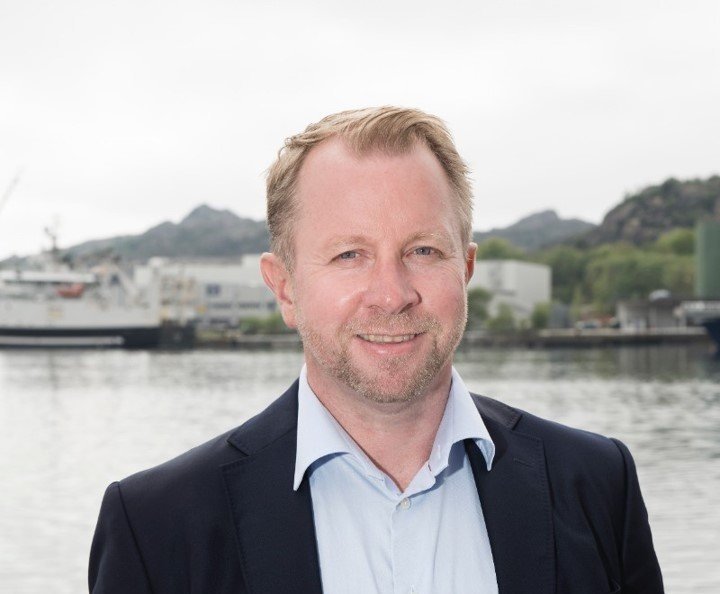Cluster Catch-Up: Alma Clean Power
“Tomorrow’s zero emission technology must be extremely fuel flexible”- Torleif Stokke, Alma Clean Power.
In the last Cluster Catch-up, we had a chat with TrønderEnergi about the construction of Hydrogen Hub at Hitra. Now it is Alma Clean Power’s turn.
The main goal of Bergen-based Alma Clean Power is to make a zero-emission technology available for deep sea shipping. They developed their first fuel cell for offshore use back in 1991, and are now building the world's first large-scale ammonia fuel cell demonstration on a commercial vessel.
We reached out to Head of Commercialization i Alma Clean Power, Torleif Stokke, for a chat.
Torleif Stokke, Head of Commercialization i Alma Clean Power.
What is Alma Clean Power’s primary focus right now?
Our main goal is to make a zero-emission technology available for deep sea shipping. We are currently in a pilot and demonstration phase that will prepare us for commercialization of our Solid Oxide Fuel Cell technology. The EU-funded ShipFC project will demonstrate ammonia operated fuel cells on an offshore vessel, while the Helenus project will demonstrate the feasibility of LNG operated fuel cells on a cruise ship. In parallel, we are planning the establishment of a full-scale production facility in Norway. To make sure our product meets the expectations in the market, and our offering and business models matches the needs of our stakeholders, we are in close dialogue with ship owners, ship designers and system integrators.
The EU-funded ShipFC project will demonstrate ammonia operated fuel cells on an offshore vessel.
In addition to deep sea shipping our solution can meet the needs for greener power solutions in the offshore oil and gas sector and even land-based power plants. It’s important for us to develop a flexible product that can fit many applications without any need for adaptations.
Tomorrow’s zero emission technology must be extremely fuel flexible, as it’s difficult to predict which fuels will be available at a cost-effective price in the future. Our ambition is to provide a fuel flexible solution that will give ship owners peace of mind when it comes to fuels. We are therefore optimizing the technology for seamless switching between different fuel types ranging from LNG and methanol to various hydrogen carriers such as ammonia and LOHC, among others.
What are the biggest challenges and opportunities for Alma Clean Power in the future?
We need to scale up our value chain from building kw units to multi megawatt units very quickly to meet market expectations. Solid Oxide Fuel Cell is a completely new technology for the marine market, even though it has been known for many years, and we need to change the mindset of ship owners to get them onboard. We must establish trust among our customers. Our technology will do the job, and we will be there, taking care of the equipment throughout the vessel’s life.
Torleif Stokke sees big opportunities for Alma Clean Power:
The main opportunity lies in the superior energy efficiency of our technology. Efficiency is key when energy is a scarcity, and the most valuable energy is the one we don’t use. When energy comes with a high cost, it will be profitable for the ship owners to invest in our technology, as less fuel will be needed for the same power output. The profitability will be even higher with green fuels as zero emission operations will take CO2 taxes out of the equation with a huge impact on the ship owner’s bottom line. In Alma we care deeply about the planet’s future, and it’s a great opportunity for us to contribute to a greener future and mitigate global warming.
Getting Aker onboard on the owner side, with financial strength and an industrial ecosystem to take part in, is clearly an advantage in this early stage.
How can hydrogen be a part of the solution for the future?
Pure hydrogen has its limitations related to flammability, storage and distribution and tends to be most applicable to short sea operations. But hydrogen stored in other energy carriers such as ammonia can have an important role in reducing emissions from deep sea shipping which makes up around 90% of the global fleet. We believe that hydrogen-based fuels will have an important role in the future as an energy carrier for shipping, but currently there are challenges related to green production and bunkering facilities worldwide. The availability of such fuels depends on the availability of renewable electricity to produce hydrogen by electrolysis.
What is your primary focus when it comes to sustainability?
It is to make a greener technology available at such a large scale that it can contribute to significantly reduced emissions and energy consumption in the ocean industries. As we commercialize our production, we are also looking at circular economy aspects and how to recycle our products and production waste. No conflict minerals are used in the production of our fuel cells. Due to the very high efficiency and zero emission potential of our product, it’s clear that the higher volume we can get into the market the more we will contribute to a sustainable future.
Why did you dcide on becoming a member of Ocean Hyway Cluster?
We strongly believe in cluster collaboration. Ocean Hyway Cluster has shown strong results on hydrogen and ammonia projects, and we are looking forward to participate in this work going forward, Torleif Stokke ends.
Curious about a membership in Ocean Hyway Cluster? Have a look here.
Siri Odijk Solbakken
Communications Advisor
+47 977 53 065
siri@hubforocean.no







